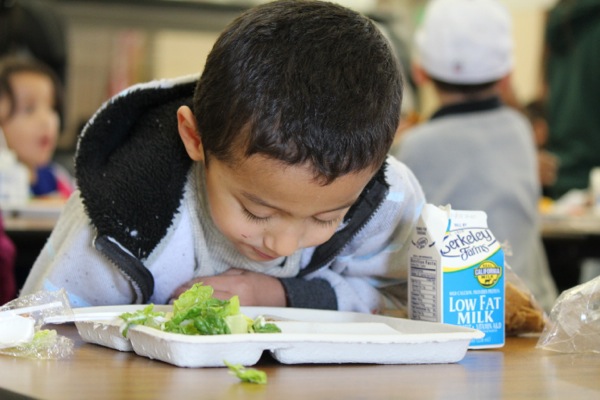
Black teachers: How to recruit them and make them stay

Lessons in higher education: What California can learn

Keeping California public university options open

Superintendents: Well-paid and walking away

The debt to degree connection

College in prison: How earning a degree can lead to a new life

A transitional kindergarten student eats lunch at his Sacramento school. Credit: Lillian Mongeau, EdSource Today
The two-ounce hamburger is no longer the rule for school lunches, after the federal government this month permanently removed limits on the amount of protein and grain allowed in meals under the federally subsidized National School Lunch Program. But does this mean the much-heralded healthier school lunches are returning to super-sized portions?
Not at all, said Lynette Rock, president of the Burbank-based California School Nutrition Association.
“The new healthy school lunch meals are still healthy,” said Rock, who is also the director of nutrition services for the Torrance Unified School District. “The relaxation of regulations on grain and protein have had no negative impact on the healthiness of the meals, because you still have the limits on the calories.”
She does not foresee the rise of jumbo hamburgers – although she says the change allows more flexibility to provide filling meals students want to eat, such as melting a piece of reduced-fat cheese on top of a hamburger or adding a larger whole-grain roll to lunch trays.
“From a business point of view, you’re not going to serve a lot of protein because it’s expensive,” Rock said of the change. “It’s not going to be more protein, it’s going to be more grains.”
Under the original regulations issued in 2012 by the U.S. Department of Agriculture, servings of grain and protein had, for the first time, maximum size limits. The guiding principle of the new lunch menus, which were part of a school lunch overhaul called for by the Healthy, Hunger-Free Kids Act of 2010, was to reduce childhood obesity and encourage healthy eating.
Meat or protein equivalents, for instance, could be no larger than a two-ounce serving; in elementary schools, grain servings were limited to nine per week, meaning that schools could not offer a sandwich five days a week. At the same time, the regulations required schools to serve fat-free or low-fat milk, a variety of fruits and vegetables, including dark leafy green vegetables and orange vegetables, reduced-fat and reduced-sodium foods and more whole grains. The meals had to meet strict calorie limits: 550-650 calories in elementary school, 600-700 in middle school and 700-800 in high school.
Some school nutritionists balked, saying the two-ounce limits on protein and grains made it difficult to provide appealing, filling meals that had enough calories. Some students reportedly boycotted the healthy meals; students and teachers in Kansas made a video, “We Are Hungry,” complaining that the smaller portion sizes made them weak with hunger. A few school districts around the country said they would quit the National School Lunch Program, saying its menu restrictions were too cumbersome.
But others, including author Marion Nestle, a nutrition professor at New York University, said the restrictions appropriately encouraged students to eat more fruits and vegetables, and that efforts to overturn the restrictions were driven by the agriculture industry.
Still, the federal government removed the maximum limits on grain and protein temporarily in late 2012 and now has eliminated the maximums permanently.
“I am ecstatic about it,” Rock said. “It makes menu planning so much easier.”
Barbara Lee, director of campus catering for the Livermore Valley Joint Unified School District, described how the protein and grain restrictions of the past drove her reluctantly to turn to high-fat salad dressing to provide enough calories in an entree salad served with grilled chicken and a small whole-grain roll.
“You have this wonderful, beautiful salad but it doesn’t have enough protein or calories, so you back-fill it with full-fat dressing,” Lee said. “The better option is we can increase the protein and also look at the grain that’s offered.”
Schools appear to have made the adjustment to the new regulations. By March 2013, more than 70 percent of U.S. school districts reported they had met the new standards and 94 percent of districts said they expected they would meet the standards by the end of the 2012-13 school year, according to a report released in fall 2013 by the Kids’ Safe and Healthful Foods Project, an initiative of the philanthropic organization the Pew Charitable Trusts.
The push for healthier school meals continues, according to the agriculture department, which cited its farm-to-school programs that provide fresh vegetables and fruits to schools, as well as new grants for school kitchen equipment. Last month, the department announced that California is among 14 states, the District of Columbia and Guam to receive a total of $11 million in grants to help schools purchase new kitchen equipment to make it easier to prepare healthier meals.
Jane Meredith Adams covers student health. Contact her and follow her on Twitter @JaneAdams.

A grassroots campaign recalled two conservative members of the Orange Unified School District in an election that cost more than half a million dollars.

Legislation that would remove one of the last tests teachers are required to take to earn a credential in California passed the Senate Education Committee.

Part-time instructors, many who work for decades off the tenure track and at a lower pay rate, have been called “apprentices to nowhere.”

A bill to mandate use of the method will not advance in the Legislature this year in the face of teachers union opposition.
Comments
Comments Policy
We welcome your comments. All comments are moderated for civility, relevance and other considerations. Click here for EdSource's Comments Policy.